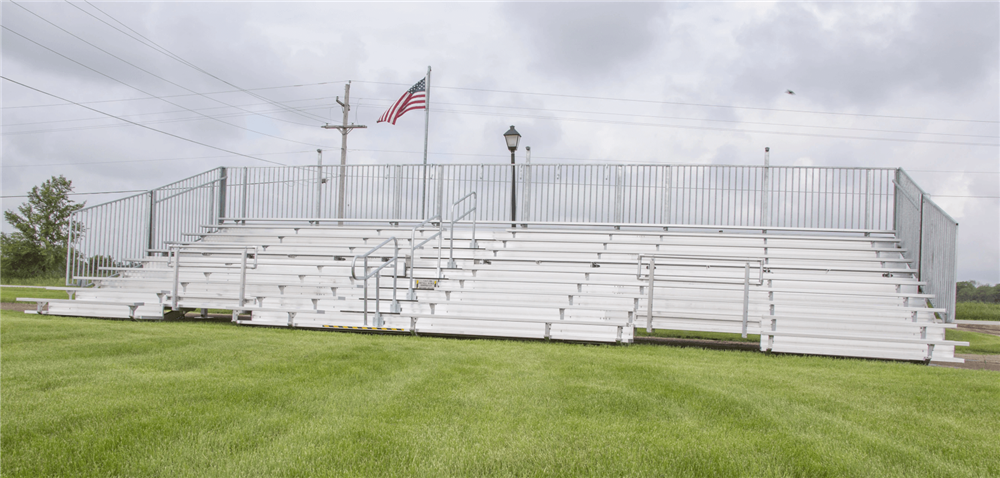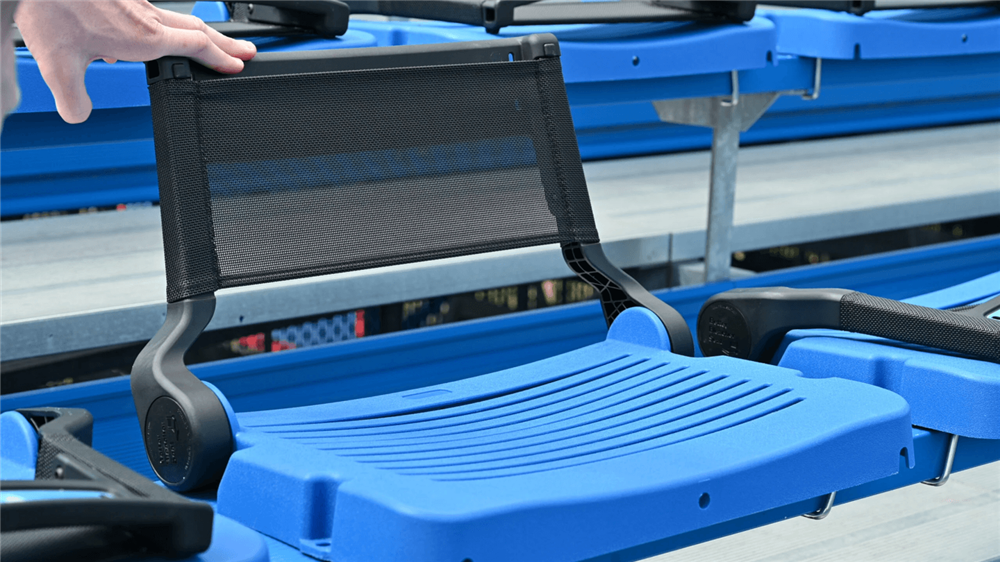Bleachers and grandstands provide comfortable seating and optimal viewing experiences for spectators. While they both serve the same purpose, there are notable distinctions in their design, capacity, and features. Whether you're planning to install spectator seating in a sports stadium, concert hall, or outdoor event space, it's crucial to make an informed buying decision. In this comprehensive guide, we will walk you through everything you need to know before purchasing bleachers and grandstands. From different types and customization options to safety considerations, we've got you covered!

Types of Bleachers and Grandstands
Fixed Bleachers
Fixed bleachers, AKA Stadium Bleachers, are permanently installed structures that supply a dedicated seating area for spectators. They are typically constructed using durable materials such as aluminum or galvanized steel. Fixed bleachers offer stability and long-term seating solutions, making them ideal for venues with consistent seating requirements such as high school sports fields and racetracks. However, they lack mobility and flexibility.

Portable Bleachers
Portable bleachers are designed to be easily transported and assembled in various locations. They offer flexibility and can be quickly set up or disassembled as needed. Portable bleachers come in a range of sizes and design options such as the 2-row bleacher which is light enough to be carried by hand or the stadium 27 foot 5-row bleacher with wheels for easier movement. This mobility allows the ultimate flexibility based on specific event requirements. While they may not provide the same level of durability as fixed bleachers, they are an ideal choice for indoor multi-purpose auditoriums, small theaters, and grade schools.

Grandstands
Grandstands are larger and more substantial structures with multiple sections built on a raised platform or structure and include aisles, stairs, and walkways. Grandstands may also have additional amenities like concession areas, restrooms, and VIP sections. They can accommodate a larger number of spectators due to their elevated multi-level design and the inclusion of these additional facilities. A typical grandstand is fixed to a single location as they are designed to integrate with the venue's architecture. However, portable grandstands are on a foldable hydraulic platform and are highway towable. Perfect for traveling shows and concerts. Grandstands
Factors to Consider Before Purchasing
When deciding between commercial bleachers and grandstands, there are several key factors to pay attention to.
Capacity and Seating Requirements
First, assess the expected attendance and choose a seating option that comfortably accommodates the desired number of spectators. This will depend on the size of your venue, the type of events hosted, and any specialized seating requirements such as ADA compliance and VIP sections. Both commercial bleachers and grandstands come in various sizes and configurations, allowing for different seating capacities.

Venue and Event Considerations
Where will the bleachers be installed? Outdoor bleachers are designed to withstand weather conditions but the spectators may appreciate being covered during poor or hot weather conditions. Shade structures for bleachers may be available depending on size while grandstands may require integration with existing architectural elements.
Additionally, specific events may have unique requirements or regulations that need to be taken into account. Pay attention to ADA accessibility requirements, including ramps, handrails, and designated wheelchair spaces. Safety features such as non-slip surfaces and guardrails should also be taken into account.
Budget and Financial Planning
Establish a budget and the cost implications of different types of bleachers. Fixed bleachers may require a larger upfront investment but have lower maintenance costs over time, while portable or retractable options might be more affordable initially but require regular maintenance. Factor in long-term maintenance and operational expenses as well.
Durability and Maintenance
Evaluate the materials and construction quality of the bleachers. Materials such as aluminum and galvanized steel are known for their durability and resistance to corrosion. However, it is still important to maintain that resistance by properly treating or coating the metal with routine care. Pay attention to the construction quality of the bleachers or grandstands. Look for well-designed and precision-engineered structures that are built to withstand heavy loads and constant use. The connections, joints, and fasteners should be sturdy and secure to ensure the overall structural integrity of the bleachers. Inspect for any signs of damage, including loose or damaged components, and address them promptly.
Logistics and Installation
Assess the logistical and installation process associated with the chosen type of bleachers. Site preparation, including leveling the ground and ensuring proper anchoring, is essential to support the structure. Consult with experts, such as structural engineers, to evaluate the site's suitability and any necessary groundwork that needs to be handled before purchasing. Determine whether there are any restrictions or challenges, such as narrow entrances, low bridges, or uneven terrain, that may impact transportation and installation. Check local regulations and permit requirements and collect all the necessary permits prior to getting started.
Customization and Additional Features
When it comes to event seating, there is no one-size-fits-all solution. That's why it's important for bleachers and grandstands to offer additional features and customization options to meet specific needs.

Seating Options and Accessories
Explore different seating options such as bench-style or individual seats for enhanced comfort for spectators. Incorporate cushioning such as a folding seat which adds extra comfort and attaches directly to a bench-style bleacher. Low-rise bleachers with double foot planks will add more legroom so spectators can spread out more comfortably.
Branding and Customization
Customization options create a cohesive look and enhance the venue's branding. Match the bleachers with your venue's color scheme, such as colored risers or banners strung across the guardrails. By incorporating branding elements, you can create a visually appealing seating area that aligns with your venue's identity.
Technology Integration
Explore the integration of audio and visual enhancements into the bleachers. This could include features like built-in speakers or screens for displaying event information. By leveraging technology, you can create an immersive environment that keeps spectators engaged and informed throughout the event.

Summary and Conclusion
To recap, purchasing bleachers and grandstands requires careful consideration of various factors. Assess your seating requirements, venue specifications, safety features, budget, and maintenance needs. Don't forget to explore customization options that meet your specific needs. By following these guidelines, you'll be well-equipped to make an informed buying decision that ensures a comfortable and enjoyable experience for spectators.
FAQ
Q: Are portable bleachers as durable as fixed ones?
A: Portable bleachers may not offer the same level of durability as fixed ones due to their design and construction. However, with proper maintenance, they can still provide long-lasting seating solutions.
Q: What safety features should I look for in bleachers and grandstands?
A: Bleachers or grandstands should be constructed using high-quality materials, such as durable galvanized steel or aluminum. The structure should be designed and built to meet industry standards for safety. Adequate guardrails and handrails should be installed along the edges of the seating areas and any raised platforms to prevent falls and offer support for spectators. The walking surfaces, including steps, platforms, and aisles, should have non-slip surfaces to minimize the risk of slips, trips, and falls, especially during inclement weather or when the surfaces are wet.
Q: How can I ensure ADA accessibility in my seating arrangement?
A: Allocate designated spaces for wheelchair users throughout the seating arrangement. These spaces should be positioned to provide unobstructed views and allow for accessible routes from the entrances to the seating areas, as well as to amenities such as restrooms and concessions. Follow the seating requirements set forth by the Americans with Disabilities Act to check that there is sufficient space for wheelchair maneuverability. If your seating arrangement has elevated sections, make sure the accessible setting has a route from the ground to the seat via ramps or lifts. There must be proper handrails, clear signs, and slip-resistant surfaces. Most important is to maintain the upkeep and stay up-to-date with any changes to the ADA requirements.
Q: What is the typical lead time for bleacher installation?
A: The lead time for bleacher installation can vary depending on factors such as the type of bleachers, customization requirements, and the manufacturer's workload. Give our staff at Furniture Leisure a call for a free quote today.
Q: Can I customize the color of the bleachers to match my venue?
A: Many suppliers offer customization options, including color choices, to match the bleachers with your venue's aesthetics. Discuss color customization possibilities with your supplier.
Q: Do retractable grandstands require additional maintenance?
A: Yes, retractable grandstands typically require regular maintenance to ensure smooth operation. This may include lubrication, cleaning, and inspection of hydraulic mechanical components. Consult the manufacturer's guidelines for specific maintenance requirements.


















































































































Leave your comment